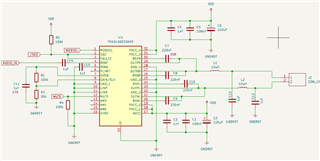Other Parts Discussed in Thread: TPS61088
Hello everyone,
For one of my University project, I need to build an audio amplifier to drive one speaker.
So far, I have chosen the TPA3130 because it seems to be a good candidate.
I’m asking for your expertise to review my calculation and check my schematic.
See below context and input parameters of the project :
The audio signal will come from an ESP32 (DAC GPIO25).
There will be two ways of powering the board :
- 10V coming from a power supply.
- 10V coming from a li-ion battery. (I think the TPS61088 could be a good a candidate to boost this li-ion voltage to 10V.)
The input is single ended and the device is in monomode (PBTL).
Settings :
Output power I want: 10W
Speaker impedance: 4Ω
Power supply: 10V
Voltage input (audio): 3.3V (coming from ESP32 DAC)
Calculation :
Output Power :
From figure 14, I assumed 10V is enough to output 10W. But the chart is given in BTL mode. So, value in PBTL is double?
Gain to set :
Po = [Vo(rms)]²/Rl → Vo = sqrt(10x4) → Vo = 6.32V
Vin(rms) = Vin(pp)/2sqrt(2) → 3.3V / 2sqrt(2) → Vin(rms) = 1.16V
G = Vin/Vo → 6.32/1.16 = 5.44 V/V → 20log(5.44) = 14.7dB
Estimated Consumption :
From the chart in the datasheet, the efficiency for 10W at 12V is 0.85.
Consumed Power = Output Power / Efficiency → Pc = 10/0.85 → Pc = 11.7W
Supply current = 11.7W / 10V Ia = 1.17A
In fact, since I’m using a 10V power supply, the consumption should be lower, right ?
There is my first draft of the schematic below:

I still need to define the AM modulation, but I think this not a big issue.
Do you have any advice regarding the schematic and in the project in general?
Thanks for you help,
Sincerely,
Thomas.

